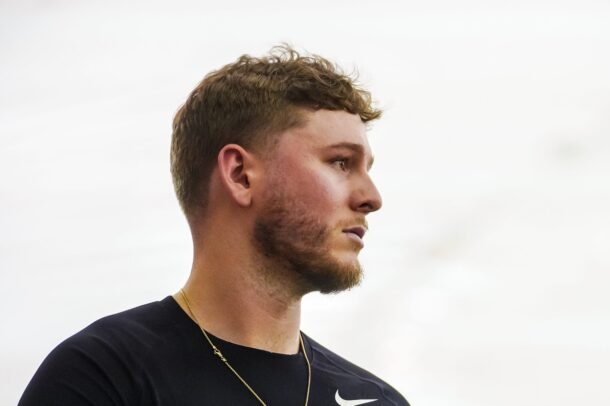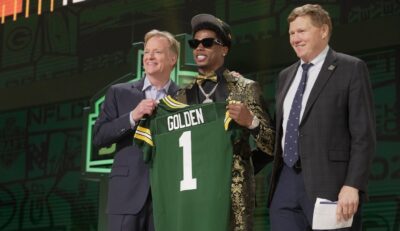Ad Disclosure

For every Quinn Ewers action, there was an equal and opposite reaction.
When he reclassified and signed with Ohio State out of high school in 2021, Ewers did so with a perfect 1.000 rating in the 247Sports composite rankings and a projection of being a future top-10 pick. When he left college with a year of eligibility remaining in 2025, Ewers did so with a Day 3 projection that ultimately proved to be true when the Miami Dolphins took the Texas quarterback in the 7th round of the NFL Draft.
One could look at those 2 truths and come to the conclusion that — barring a Brock Purdy-like rise at the next level — Ewers will have earned the dubious “bust” distinction.
Dare I say, it’s more complicated than that.
Newton’s Third Law of Motion could be applied to plenty of elements of Ewers’ career. Whether that was the motion-heavy offense that Ewers led for 3 years under Steve Sarkisian, or the somewhat constant changing circumstances in his career, it’s fair to say that the late Sir Isaac Newton himself would cite Ewers’ college career as a 1-of-1 case study.
Sandwiched between those opposite reactions were a whole lot of … “interesting” moves. Some were financially motivated, some were not.
You could point to a quarterback who left a year of eligibility on the table for a 7th-round selection as a “not about the money” decision. Two things can be true at the same time. One is that Ewers didn’t anticipate going in the 7th round. The other is that Ewers almost certainly would’ve collected more money on a 1-year deal as a transfer quarterback than he would’ve earned as a non-Round 1 guy, but he didn’t want to start over somewhere else. A $2 million asking price for a player as decorated as Ewers feels like a conservative estimate considering that transfers like Carson Beck and Darian Mensah netted close to an estimated $4 million. Make of that what you will.
But Ewers has been pretty open about the financial benefits of his decisions. Not only did he start his college timeline a year early at Ohio State to begin capitalizing on his NIL opportunities (he couldn’t do that playing high school football in Texas), but he also returned to the Lone Star State under the understanding that the monetary gains were significant. When asked about that subject — whether he only transferred to Texas to play with Sarkisian or if there was any other opportunity that would’ve made sense for him — he was pretty candid.
“There’s multiple reasons that went into transferring. Number one, I just wanted to be closer to all my resources,” Ewers said on The Saturday Down South Podcast in Dec. 2024. “I felt like all my resources were back in Texas, and just being away from that wasn’t very beneficial for me. And just being closer to my family, I just love being around my family. I didn’t really get that at Ohio State. Growing up (in Texas), it was hard leaving and it was even harder being away from Texas. I grew up wanting to play here and it took me a minute to really realize that.”
That’s a complicated answer.
Ewers might’ve valued being “closer to all his resources,” but he joined a 5-7 program and left it after helping get it back to national relevance. Nobody can take that away from him. And while “quarterback wins” are often the spin zone to describe signal-callers who simply avoided messing up ideal surroundings, one shouldn’t dismiss the performances that defined Ewers’ career.
In 2023, he stunned Alabama with a masterful performance in Tuscaloosa, and he walloped Oklahoma State in the Big 12 Championship, which Texas hadn’t won in 14 years. In 2024, he was brilliant on the road against defending champ Michigan to help Texas earn its first No. 1 ranking in the AP Poll in 16 years, and his 4th-and-13 touchdown pass to Matthew Golden to survive the Peach Bowl against Arizona State was one of the most clutch plays of the Playoff era.
None of the 12 quarterbacks selected ahead of Ewers in the 2025 NFL Draft had to fend off a player as decorated as Arch Manning for multiple years, and none of those signal-callers ended their college careers riding consecutive trips to the semifinals. By any stretch, Ewers was the best Texas quarterback since Colt McCoy.
If you had told any Texas fan in 2021 that Ewers would check those boxes by the time his career finished, they would’ve taken that in a heartbeat. “Bust” would’ve been the furthest thing from their mind.
But with Ewers, it’s complicated.
Durability became a question throughout a college career that saw him miss multiple games to injury in all 3 of his seasons as Texas’s starter. The effortless throwing motion that earned him those lofty recruiting rankings never quite turned into game-changing downfield ability, and he lacked defining strengths in the eyes of next-level evaluators. Sarkisian tweaked the offense to Ewers’ limitations, which was reflected with just 12.4% of his attempts traveling 20 yards past the line of scrimmage (that was No. 99 in FBS among QBs with at least 30 such passes).
When NFL Network reported at the NFL Combine that Ewers played with a torn oblique that he suffered in that aforementioned Michigan win and not just a strained oblique as originally expected, it might’ve earned him more toughness points for playing through that injury, but it clearly didn’t help his draft stock. Ewers tried playing at different weights throughout his career, and that didn’t change his durability. If you had a nickel for every time his weight-loss transformation was mentioned during a 2023 broadcast, you would’ve had resources like Ewers.
Bank accounts don’t define legacies, though. It is fair to wonder what Ewers could’ve done to change his legacy if he had followed the path of someone like former Red River Rivalry counterpart Dillon Gabriel. He opted to leave Oklahoma in his final year of eligibility because the Sooners were set to move on to 5-star quarterback Jackson Arnold. Ultimately, Gabriel cashed in at Oregon by leading the Ducks to a Big Ten Championship. He added a slew of NCAA records and a Heisman Trophy finalist nod to his legacy. Go figure that the 5-11, 24-year-old Gabriel went in Round 3 while Ewers nearly went undrafted.
The good news for Ewers is that he’ll play for another elite offensive play-caller in Dolphins coach Mike McDaniel, who also knows a thing or 2 about the Laws of Motion. Go figure that the guy Ewers will be playing behind, Tua Tagovailoa, also spent his final college season in Sarkisian’s offense. Perhaps we’ll hear camp stories about Ewers being motivated by his late selection. Alternatively, this could be the last time that he’s a topic of national conversation.
Either way, Ewers’ college career deserves to be dissected with proper context. Did he live up to expectations as a generational recruit? We can confidently say that a guy who never earned first-team all-conference honors fell short of that. But did Ewers flame out and become some cautionary tale of what hype can do in the NIL world? We should be able to confidently say that he doesn’t belong in that camp.
Equal and opposite reactions were aplenty for the complicated Ewers.
Connor O'Gara is the senior national columnist for Saturday Down South. He's a member of the Football Writers Association of America. After spending his entire life living in B1G country, he moved to the South in 2015.



